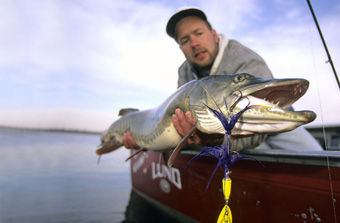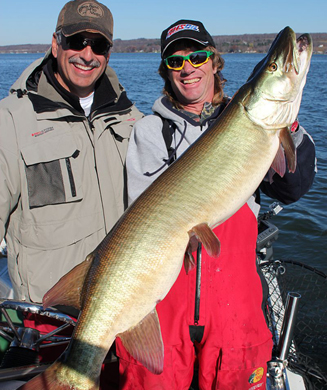
– Sturgeon
– Carp
– Flathead Catfish
– Paddlefish
– Blue Catfish
– Largemouth Bass
– Alligator Gar
– Lake Trout
– Striped Bass
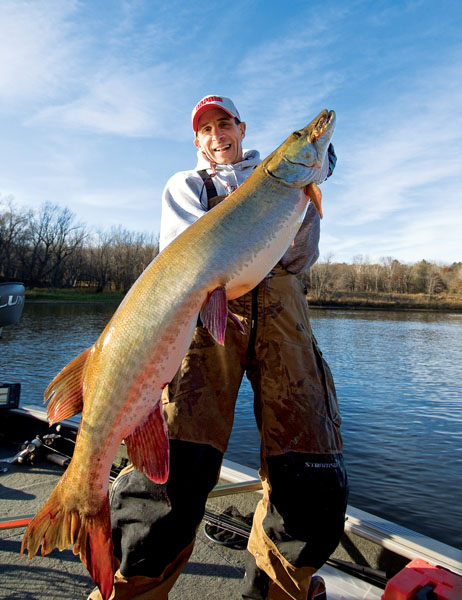
Giant fish with a nasty attitude If you are looking for the most exciting fish to catch in the heavyweight division, this may well be it. The muskie is a top-of-the-food-chain predator that doesn't give a damn about anything but eating. As a matter of fact, these fish will eat fish the size you normally keep. Many a largemouth bass being reeled in by anglers has been inhaled by these beasts mid-fight, according to John Riegel, who guides on the Oconomowoc River System in Wisconsin. "And there is no fish that can match the explosiveness of a bite when a muskie decides to eat," the Wisconsin angler says. When to Go
When to target these finny torpedoes really depends on how you want to catch them. Riegel's favorite time to go is in summer–and at night. "The first four muskies I caught were at night on a topwater bait, a Hi-Fin Hawg Buster. If you don't think a fish can make you pee your pants, I dare you to fish for muskies at night on top! "Most of my night fish average about 30 pounds. But, man, when a 30-pounder hits near the boat in utter darkness, you will never forget that moment." Top Tactic
Again, how best to catch muskies depends on the time of year. But for the most consistent action, Riegel likes fishing fast in June. "Muskies have to eat four or five times per day during the summer months because they burn so much energy in the warm water. This gives anglers more chances to catch 'em feeding. So, when you're fishing in summer, think speed. Blow lures past fish. Just try to outrun a muskie–ain't gonna happen," the guide promises. A local favorite for muskie burning is the 6 ¾-inch Strike Pro Flex Phantom swimbait. What You Need
"The advent of 8- to 9 ½-foot rods has really helped muskie fishing," Riegel says. "Once you get a fish following you, these long rods allow you to make wider turns with the figure 8." Along with the long rods, the guide prefers the Revo Torro reels from Abu Garcia. They are a low-profile reel but hold a ton of line. "I use 80- to 100-pound braid and a 130-pound fluoro leader–I get more bites with fluoro."
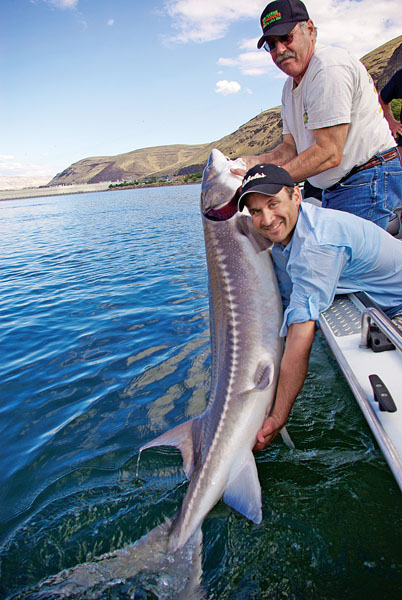
Your largest freshwater fish–bar none Go stand on your fishing partner's shoulders. Assuming you are both about 6 feet tall, the pair of you, stacked like acrobats, will reach the length of a nice-size sturgeon. If you dare tackle a fish this size, follow Todd Brenton's advice. When to Go
"For the really big fish, you want to target May through August, with your best chance being in June," says Brenton, who fishes the Columbia River in both Washington and Oregon. "The monsters will move in to spawn during this time." Top Tactic
"Look for seams in the river current," Brenton says. "The big fish can't hold in fast current. So find deep holes and watch your electronics. I've seen the actual outline of sturgeon displayed on my sonar." What You Need
You can't catch a 10-foot fish on light tackle. A broomstick rod and heavy saltwater reel is necessary. Brenton likes to use 120-pound braid for his main line. Next, with a barrel swivel, he ties a 2-foot section of 200-pound Dacron, which holds a heavy sliding lead weight (size depends on current). He then attaches another swivel with a final 2-foot section of 180-pound Dacron sporting an 8/0 treble hook. "The best bait is a fresh American shad," he says. "The 1-pounders are about the perfect size, but we'll fillet a 3-pound shad if that's what's available."

The "trash" fish that's a trophy How this species became known as undesirable, Brian McGeehan will never know. "Carp are an incredibly challenging gamefish. They are spooky, get big, and fight hard," says the owner of Montana Angler Fly Fishing guide service. **When to Go **
Although you can do some damage in May, McGeehan prefers the summer on the upper Missouri River. "Late July into August is my favorite time. The fish are in predictable areas of the river and don't hesitate sucking in a dry fly off the water's surface." Top Tactic
Although there are plenty of targets to choose from, it's anything but Flyfishing for Dummies. "Your cast has to be super-accurate. You need to drop your fly within 6 inches of a fish's nose, or you will not get bit." What You Need
"You need at least a 7-weight rod, because there's a buttload of current," the Montana resident states. He leans toward an Adams dry fly pattern.

A frightening mix of ugly and huge Of all the big freshwater fish on this list, the flathead may be the ugliest. It looks like a turd with whiskers. However, they grow to enormous sizes and are considered quite elusive in the catfish world, making them prized catches. Chad Ferguson guides for these pan-headed beasts on North Texas' Brazos River, a fishery rich with the species. His biggest to date reached nearly 75 pounds. When to Go
"Flatheads get really lethargic in cold weather, so your best chances of catching a big one are as the weather warms in early spring, or right before it gets cold in the fall," the Texan explains. And avoid daylight. These fish are nocturnal and prefer to eat at night. Top Tactic
"The crazy thing about flatheads is that they are like cattle. They take the exact same path each time they move from one spot to the next. Old-timers will walk the river with their shoes off to find these trails on the bottom and set up trot lines in high-traffic areas," Ferguson explains. Once you find these paths, it's a waiting game. Unlike the flathead's whiskered brethren, this particular species prefers live bait over dead options. "I have the best luck with medium-size to large live bluegills," the Texas guide says. What You Need
Ferguson uses two rigs exclusively: A slip sinker rig (big Carolina rig) with an 18-inch leader, a 1 ½-ounce lead barrel weight, and an 8/0 circle hook; and a Santee Rig, which is basically the same setup, but with a small float positioned in front of the hook to lift the bait off the bottom. "Flatheads can be tough to catch," the guide says. "But when you hook into a 50-pounder, you've really accomplished something–a big something."
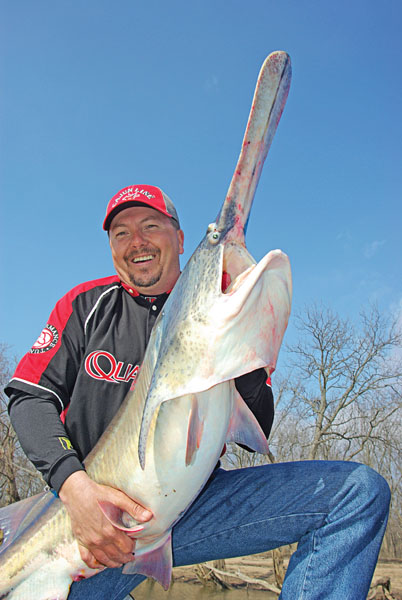
Hook'em hard and hang on tight If you want the biggest fish you are likely to catch to also be the most unusual, then head to Grand Lake, Oklahoma, for one of these freshwater freaks. Ray Austin, owner of Dempsey's Fishing Guide Service, believes there's no better spot in the nation to hook a paddlefish that weighs more than 50 pounds. When to Go
Although Austin starts catching these billfish in November, peak season is March and April, when they move into the tributaries to spawn. Best Tactic
Because paddlefish are filter feeders, you cannot dupe them with a lure or bait. You have to snag them. "I find a pod of them with my electronics, position the boat above them, and then drop my snag hook to the bottom. It's like a video game. I can tell you which side of the boat they are on, when you are in the zone, and almost how much each fish weighs," Austin says. What You Need
A long rod moves more line when you're trying to jerk a hook through the leathery skin of a spoonbill, so Austin uses an 8-foot, heavy-action saltwater rod. He spools a Penn reel with 90-pound Spiderwire braid.
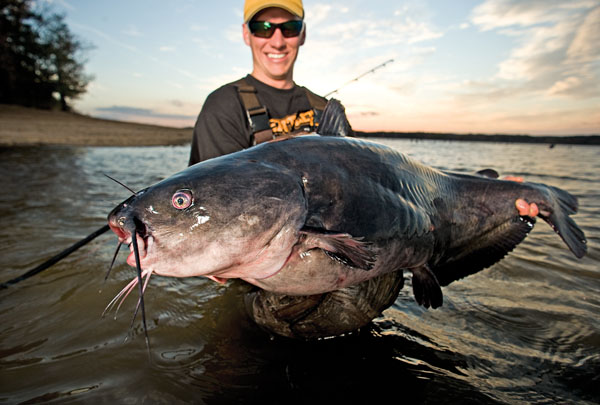
The bottom-feeding leviathan It's difficult to pinpoint one spot to catch these brutes of the catfish family because they can be found in most big rivers and tributaries in the central and eastern U.S. However, Scott Bannon, co-owner of Big Cat Guide Service believes Virginia's James River to be tops in the country. "My biggest was an 81-pounder, and we have landed countless blues in the 50- to 60-pound range," he says. When to Go
Surprisingly, Bannon believes the colder months are best. "Cooler weather makes the big fish predictable. They will get on structure like a sunken barge or defined channel ledge and hang out, as long as bait is there," he explains. Depth, he believes, is unimportant, as he has caught blues from 6 feet down to 60 feet deep. Top Tactic
What is important, however, is the bait you use. "Use fresh-cut gizzard shad, 1- to 4-inch chunks. The big boys will turn their nose up at frozen bait," he says. What You Need
You also want to use hefty gear, as these fish are not only big, but are likely the strongest of the catfish family. Bannon opts for a Penn 320 saltwater-grade levelwind, a 7-foot Ugly Stick, and 50-pound mono main line. The rig is simple: a Carolina rig featuring a 14-inch 100-pound leader, a ½- to 6-ounce weight (depending on current), and an 8/0 circle hook. Fishing multiple rigs, where legal, is a great way to get these scent-feeders to take a bait.

Back-breaking world-beaters**
**
No, largemouths don't necessarily belong on this list. But here, we're talking teeners. And when you talk about largemouths of that size, you point westward. "You gotta have trout to consistently grow bass in the teens," says southern California guide Rod Thigpin, whose biggest bass to date weighed 16 lb. 2 oz. **When to Go **
"My favorite time to throw swimbaits for teeners is February," says Thigpin. "That's when bass have started to position themselves predictably on deep structure, preparing to move shallow to spawn." Top Tactic
"Once the trout are stocked, big bass will set up on deep ambush points. So I like to focus on ledges, humps, and points in the 15- to 40-foot range," Thigpin explains. The guide casts from the shallowest point of the structure to deep water–letting his bait sink to the bottom–and employs a steady retrieve. What You Need
Although there are countless swimbaits available, Thigpin prefers a bait he designed in the early '90s, the RT Custom Lures Stocker Trout. He casts this bait, generally the 10-inch version, on a Loomis swimbait rod and a Shimano Calcutta 400.

Catch an armor-plated dinosaur Easily the most intimidating looking fish on this list, the alligator gar may also be the most difficult to catch, according to longtime gar guide Bubba Bedre of Palestine, Texas. "It's damn hard to hook a trophy-size fish–I don't care who you are," the Texan says. Although he guided a client to an 8 ½-footer that was shot with a bow in a small lake off the Trinity River, Bedre now only fishes for these toothy critters with a rod and reel. When to Go
"In the winter, they are very lethargic and almost seem to hibernate. So your best chance for action is spring through early fall." Top Tactic
Set up on a deep hole where you've seen alligator gar surface. They generally will remain in the deepest portion of the river. Bedre ties up to a tree along the riverbank and casts a weightless bait into the hole with a float attached. Besides hook selection (No. 4 treble ), the most important part of hooking an alligator gar is patience. What You Need
Bedre uses cut carp or cut buffalo for bait, noting the bloodier, the better. "Gar are like the buzzards of the fish world–they swim around eating scraps," the guide explains. He employs a short 5 ½-foot rod built for catching tuna and spools a Penn levelwind with heavy mono followed by a 12-inch leader of 49-strand wire."
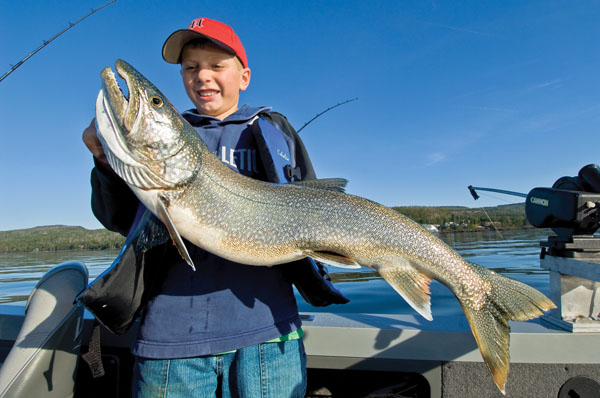
This trout's got game–and then some If you want to forgo hard-to-catch fish and simply angle for a willing, mean-spirited brute, the lake trout is your guy. You will catch one–and likely many more–if you hit the sandbar at the mouth of the Niagara River and Lake Ontario. "This spot holds a smorgasbord of bait, from emerald shiners to gobies to smelt. And it seems the lakers cruise around here with their mouths open 24/7," says Frank Campbell, whose best fish weighed 35 pounds. When to Go
January 1 through the end of May is very good. Any one day within this range could offer anglers world-class lake trout fishing. Top Tactic
"Three-way rigs with a Lindy River Rocker is one of my favorite ways to catch big fish," Campbell says. "You simply find schools of bait around the huge horseshoe-shaped trench that surrounds the sandbar, then drop your three-way rig down to the bottom. The wind and/or current will push you along, allowing you to troll your bait through the feeding area." What You Need
Campbell likes to use light gear for lake trout, even though they grow big. "I like medium-action 7-foot rods paired with a baitcaster that can hold a lot of line. My main line is 10-pound fluorocarbon leading to the three-way swivel. I use a 12-pound fluoro leader, about 6 feet long, for the bait. My bottom leader that's tied to a 1-ounce weight is only about 8 inches long," the longtime guide explains.
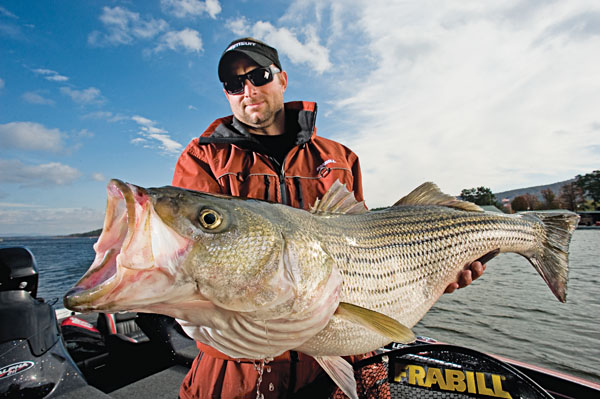
Man up for the baddest bass of all time Ralph Dallas (615-824-5792) holds the current Tennessee record for striped bass, at 65 pounds 6 ounces, but he's hooked a bigger one on his favorite stretch of Cumberland River System water. "I had a fish spool a client of mine one day. It simply never stopped. A couple of days later, I went back to the same spot and saw a monster striper floating. It had my line and rig wrapped on a tree and couldn't free itself. Based on its measurements, it would have weighed more than 70 pounds," the longtime guide explains. When to Go
The last week in March to mid-May offers the best chance to land a trophy, according to the Tennessee resident. "All spring is good until the fish start spawning. Once they start focusing on making babies, they are very difficult to catch," Dallas explains. Stripers spawn in open water and let their floating eggs move downstream with the current to hatch. Top Tactic
Although artificial lures can be effective for striped bass, especially Cotton Cordell Red Fins fished slowly on top of the water, Dallas believes you will catch the biggest fish on live bait. "It's tough to beat a live skipjack. I use 'em up to 20 inches long. I don't know if it's the bigger profile of these baits or their scent, but stripers absolutely love them." When using these big live baits, the Tennessee guide slow trolls them on planer boards, usually no deeper than 20 feet. "Once I find bait, I drop planer boards down and use my trolling motor to zigzag through the area. I like to go just fast enough to keep the boards down," Dallas explains. What You Need
"You absolutely must have adequate gear for these fish. They are too big and too strong for mediocre tackle, and can easily bust you off with lighter gear," the guide says. Dallas uses a 7-foot G. Loomis saltwater heavy-action rod with roller guides. He spools an Abu Garcia 7000 with 150-pound PowerPro braid (and has still had this line broken in open water). He will have from 6 to as much as 20 feet of line behind his planer board, with a circle hook through the nose of the skipjack, as well as a treble in its tail. "A good day using this technique will offer anglers upwards of five fish between 30 and 50 pounds," Dallas says. Think you made a record catch? Make sure you have the proper documentation, otherwise you won't get the credit.
We offer expert opinion on how to 10 species of the largest freshwater gamefish including muskies, bass, lake trout, catfish, alligator gar, and sturgeon.





